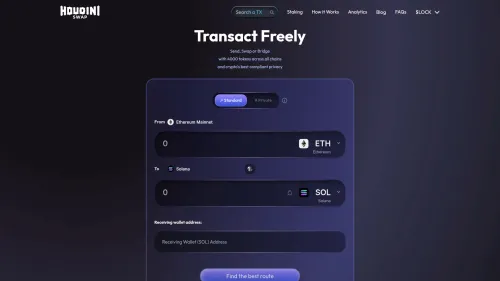Houdini Swap (LOCK)
Through an architecture blending liquidity aggregation, privacy layers, and flexible wallet options, Houdini Swap aims to become a central hub for sending, swapping, and bridging digital assets.
LOCK token
The platform’s native token, LOCK, serves as the utility token for Houdini Swap. LOCK is deployed on both Ethereum and Solana, allowing for cross-chain utility within the Houdini ecosystem. While the article does not specify its use cases, LOCK may potentially be used for fee reductions, governance, or staking as part of the broader platform roadmap.
Overview and core offering
Houdini Swap provides support for over 4,000 tokens across multiple blockchains, functioning as an aggregator of major crypto liquidity pools[1]. The platform distinguishes itself through the breadth of assets it supports but through its dual focus on user-centric design and privacy-first operations.

| Ticker | LOCK |
| Category | Privacy Coins |
| Website | https://houdiniswap.com/ |
| @HoudiniSwap | |
| Telegram | houdiniswap |
| Contract Addresses | |
|---|---|
| ethereum | 0x92...09 Copied! Copied! |
| solana | Ap...ih Copied! Copied! |
Users can choose from two main transaction methods—Wallet Connect and Manual Send—each designed to suit different user preferences around cost, privacy, and accessibility. Additionally, Private Mode introduces a unique privacy-preserving mechanism that goes beyond standard obfuscation tactics used in other crypto services[1].
Transaction methods
Wallet Connect
The Wallet Connect method leverages browser-integrated wallets such as MetaMask, Rabby, or Trust Wallet. Transactions initiated this way are executed entirely on-chain, signed directly in the user’s wallet app. This method prioritizes decentralization and user control, although it inherently lacks privacy due to the transparency of on-chain data. Wallet Connect transactions are typically lower in cost compared to alternative methods, making it a viable option for users less concerned with transaction traceability.
Manual Send
Manual Send allows users to conduct transactions without connecting a wallet directly to the platform. When a transaction is created, a unique deposit address is generated by a non-custodial exchange. Users then manually send their tokens to this address to initiate the swap or bridge process.
This method can offer increased privacy, particularly for cross-chain transactions. While technically traceable, tracking a Manual Send transaction requires significant resources and expertise. Manual Send is the only available method for some Private transactions and certain standard swap routes where wallet connection isn’t feasible.
Private Mode: Anonymity without compromise
Houdini Swap’s Private Mode is the platform’s flagship privacy offering. It is built around a layered transaction architecture involving:
- Two non-custodial exchanges
- Single-use wallet addresses
- A randomized intermediary Layer 1 blockchain
This system ensures that no single entity—neither of the two exchanges nor any external observer—can reconstruct the complete path of a private transaction.
Dual exchange structure
In a private transaction, the process is split between two exchanges:
- Exchange 1 receives the user's funds and performs the initial swap.
- The funds are then routed through a randomly selected Layer 1 blockchain acting as a privacy intermediary.
- Exchange 2 receives the obfuscated funds on the other side, performs a final swap into the destination token, and sends it to the recipient.
Each exchange only sees its part of the process and has no knowledge of the transaction's full route.
Role of the Layer 1 privacy intermediary
The randomized Layer 1 (L1) acts as a privacy layer between the two exchanges. Commonly used L1s include TRX, LTC, SOL, and DOT, chosen for their deep liquidity and large transaction volumes.
Since the L1 is randomly selected and undisclosed, and both exchanges use newly created single-use wallet addresses, reconstructing the transaction path becomes computationally and analytically infeasible.
Legacy Monero routing
For users with specific privacy preferences, Houdini Swap retains support for its legacy v1 privacy layer, which utilizes Monero (XMR) exclusively. Users can toggle Monero support in settings, opting for a more traditional privacy coin route over the randomized Layer 1 method.
Data handling and compliance
Houdini Swap aims to balance transactional privacy with responsible data handling and compliance with applicable regulations.
Transaction data retention
- Private transaction data is stored for 72 hours to support customer service inquiries.
- After 72 hours, data is automatically deleted unless needed for compliance.
AML compliance
While Houdini Swap itself does not enforce Know Your Customer (KYC) procedures, its exchange partners implement risk-based monitoring and may request user information for flagged transactions. These cases are rare, and Houdini Swap’s support team facilitates communication if needed.
Website data practices
- No use of tracking cookies for individual users
- Aggregated, anonymized data is retained for product development and marketing analytics
Accessibility and user choice
A major selling point for Houdini Swap is its flexibility. The platform allows users to operate with or without a connected wallet, depending on their privacy and transaction preferences. Wallet Connect is typically required when using decentralized exchange (DEX) routes, where unique deposit addresses are not generated.
Private Mode and Manual Send, however, allow users to conduct transactions without directly connecting a wallet—further enhancing privacy.
